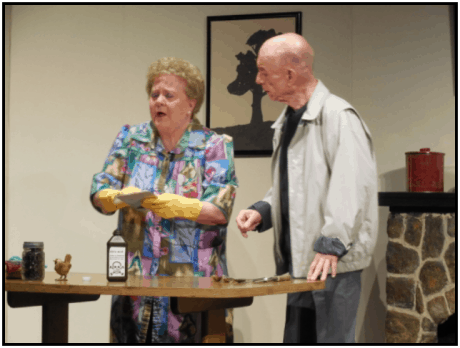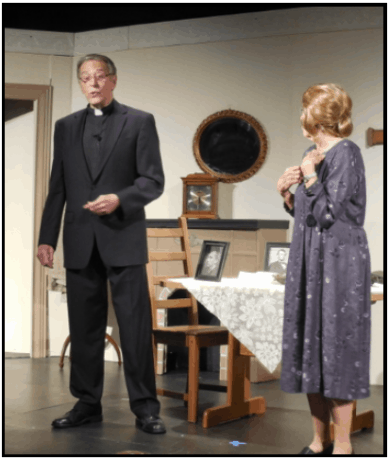
This year is the 11th Anniversary of the Greenspring Players (GP) based at the Greenspring Retirement Community‘s Village Theater in Springfield, VA. I was fortunate to have a roundtable discussion with the actors and directors involved in the three plays discussed below. GP will be presenting Dial M For Murder on November 11, 12, 14 and 15th, 2014. So, if you can appreciate the senior perspective you are reading below, we encourage you to mark your calendars and attend. Further ticketing information is included at the end of this post.
One important point concerns revenue raised through ticket sales at Greenspring. For seven years now, juniors and seniors who are matriculating at George Mason University School of Theater are eligible to apply for two $1000 scholarships awarded yearly based on the applications received. This is a wonderful way of recognizing that theater’s future will be based on the younger generation and what a constructive way to share the profits of every production.
______

Kay Cumbie on Not My Cup of Tea
Kay played the part of the mother in this three character play and performed opening night and the last night while another actress played the other two nights. The attendance was superb and Wednesday night’s performance was sold out.
Eric: Do you have any experience doing theater before you arrived at Greenspring?
Kay: I started out at age 5 (about 80 years ago). During the great depression, my kindergarten teacher, who was starving to death at that time, offered for $1.00 a month to teach elocutionists. Through the years, I was doing lots of stuff, but I learned to love the stage and not be afraid of it. I have been nervous but never afraid. And, I am a clown… that helps.
What is Not My Cup of Tea about?
Kay: The plot focuses on the comedic aspects of the story. So, when the curtain rises, the play presents the mishaps of the mother and her two aging spinster daughters. The daughters’ number one focus in life is to inherit their mother’s money and how to accomplish that endeavor. The mother is aware of her daughters’ desires and is upset about her predicament. Mother decides she has to murder her daughters. Simultaneously, each are planning the other’s demise….the mother is boiling poison tea while the daughters are baking poison cookies.
How long was the play?
Kay: It was 20 minutes long.
Is the public invited to the event?
Kay: We don’t advertise by posting billets at the Giant, but largely depend on word of mouth.
How much do you charge for autographs after the show?
Kay: So far, I haven’t made any money on that end of the deal (the room burst into laughter). You have to understand that the GP provides me a small intimate family to rely on. Living in a Senior community of over 2000 people, the closeness of my GP colleagues helps me tremendously.
Have you been in almost every production that GP has done?
Kay: I have been in 2/3 of them.
Do you have to audition for the roles?
Kay: Absolutely… a lot of time the directors already know us so when when we audition for one role, they may think we are better for another one…but I really wanted this role and they agreed I would be best for it.
______

Howard Wachspress: Let me explain to you a little more about the process we use to select plays. We have a play selection committee that reads plays throughout the year and we are reading about 20 right now. The committee makes a prioritized recommendation list and then we search for directors. We place the plays’ scripts in the Greenspring Library, and issue a call for auditions. In my own case, I acted in my first stage preview here after my 80th birthday, about five years ago, in a show we performed, Solid Gold Cadillac, which previously played on Broadway. In fact, it was playing in downtown DC at the same time we were doing it here.
So, I guess you had more attendance than they did downtown?
Howard: YES WE DID! (laughing). In the last five years, I have been in almost every play and GP has performed dramas, mysteries and musicals. One of our biggest productions was a combo of Guys and Dolls and My Fair Lady. We selected hit songs and dance numbers from each of these shows, put them together and this was the only time we undertook such a tremendous challenge. We are fortunate to have a real theater professional living here for five years and also on GP staff who has spent his career in theater. This has provided us a huge advantage in terms of stagecraft, acting, directing, and managing. Remember, with all the residents living here, every day we are seeing and talking to our own community and constantly getting immediate feedback on our acting. Listening to people share their contrasting thoughts is like tasting chocolate and vanilla.
So, Kay, you have been in Theater longer than anyone else at the table, give me your opinion of what you think of the Broadway of yesterday versus the Broadway of today? Do you see today’s Broadway continuing to be successful and surviving?
Kay: Every segment of our population is facing real challenges— the school system, the lion’s club, the churches and the rotary club. We have a generation still around that is on the way out (but we seniors haven’t left yet) and we have a younger generation with entirely different priorities and how they express them. The results—- a clash! I perceive every segment of our society is facing challenges. The conflict/resolution is of course how each group meets these needs through compromise. With regard to your specific question about theater, I would like to discuss the revival of West Side Story which is coming to DC. The kind of dancing that is done in that show is an entirely different perspective on dancing that this generation may not even be familiar with. Another interesting point is the new techniques employed in revivals. When I saw South Pacific the first time, the set was located on a little desert island. When I recently saw this show again in New York, they had airplanes on the stage which are part of the set. Today, you have all those new special effects that one can employ which may add to the patron’s experience. For instance, when Miss Saigon was on stage in NYC, they landed a helicopter on stage, which added to the dramatics of the production.
When Artistic Director Eric Schaeffer of Arlington’s Signature Theater directed Miss Saigon last year, there was no way that they could include a helicopter in the theater, yet they utilized special effects which made the audience believe that a helicopter was indeed part of the play.
______
Deanna deMember, GP Publicity Chair: When I saw The Book of Mormon last year with my 22 year old grandson, I have to tell you that I am not one who is easily shocked, but there are a couple of things in there that proved to me that this was not Oklahoma. There is this generational difference; part of the playwright and director’s job is successfully crossing that divide.
Kay: Special effects can really make a difference. I saw a production at Ford’s Theater here in Washington, DC about the civil war and Mr. Lincoln. Tombstones followed Mr. Lincoln as he moved across the stage. This use of props can be so vivid and electrifying that they help to bring the power of the production to the patron.
Howard Wachspress and Robert Goolrick on Flattering Word
Howard: This play’s plot involved a well-known actor (Howard) in a small town who was visiting an old flame and her husband, who happened to be a minister. The minister was adamantly opposed to any theater (an instrument of the devil) and the other characters in the play focused on convincing both the minister and his assistant that everyone in life has a desire to be on the stage and in show business.

From my research, the play was written in the 1930s. Did that make the play less receptive to the audience?
Robert Goolrick: I played the role of the Minister. It was not a problem, except there is a part in the performance where my wife had to ask me for permission to go to the play. You have to take into context the 20s and 30s that could have made the play almost in a time warp. But, we didn’t play it in the 30s, we attempted to play it in “today”.
When did you get the ‘Theater Bug?’
Howard: I started my acting career singing with a recording of three other men in a barbershop quartet. I was the fourth, except I was live. That’s what got me interested – first I was building sets here at GP and then appeared in GP’s Solid Gold Cadillac. I also played small parts in My Fair Lady and Guys and Dolls (G&D). I played a role in the opening number of G&D singing “Fague for the Tinhorns.” I guess I graduated from the status of an amateur to a semi-amateur. I have to tell you that the Greenspring community looks forward to these theatrical events. Dress rehearsals can really help us actors determine how we might modify our verbiage or actions based on audience feedback, which is so critical to its success. The important point is there is a huge difference between knowing our lines, but not owning the part. People have repeatedly told me you have to feel and own the part….you can’t just recite lines.
Deanna: At the beginning of practicing these three plays, we were sitting around in a room like this and reading the parts for each other. But, we didn’t get into the performance space until 2 weeks before the performance. At that point, we had learned our lines, but now the job at hand was where and how we deliver them.
Bob and Laura Fetterolf Co-Directors of Blind Woman’s Bluff
Bob: John Carle and Jane Ford were the two actors selected for the play. Early rehearsals were accomplished in our apartment. Directing these two was both easy and hard because each had their own role ideas. Yet, working together and going back and forth culminated in a fine performance. The play is about 20 minutes long and was reviewed in a local paper entitled Mayhem at Greenspring. Opening with symphonic music, Jane plays a blind woman who lives alone who is out for revenge. She advertises that she is blind and is interested in selling a chair. John responds and in the process of his visit he loses his pants, his money and his wallet. We find out that Jane has accomplished this deceitful feat numerous times. The question at the end we are left to ponder is…who is robbing whom?
This is the first show that I directed at GP, but I worked my way up. In 1956, I was in the Army stationed near Broadway in New York. Thankfully, due to the the courtesy of the USO, I saw 15 Broadway shows while there. One, I remember – No time for Sergeants and I was fortunate that night to meet Roddy McDowall and Andy Griffith.
The running time of the three-play performance was 90 minutes.
Dial M for Murder plays at The Greenspring Community performing at the Greenspring Retirement Community‘s Village Theater – 7410 Spring Village Drive, in Springfield, VA. For reservations, contact the public affairs office at (703) 923-4690.
LINK
‘Shakespeare with a Twist – Revisited’ at The Greenspring Players by Eric Denver on DCMetroTheaterArts.





